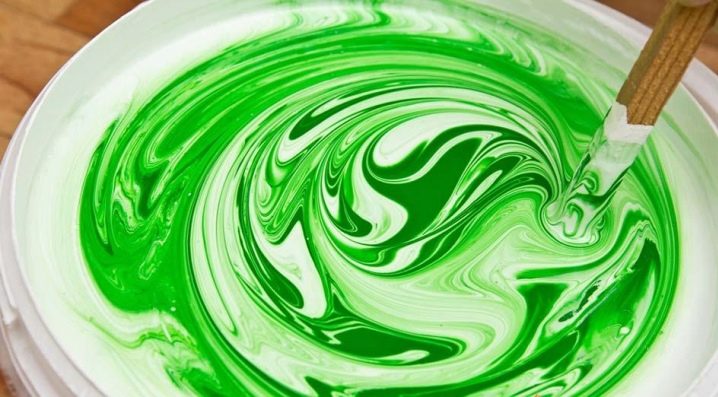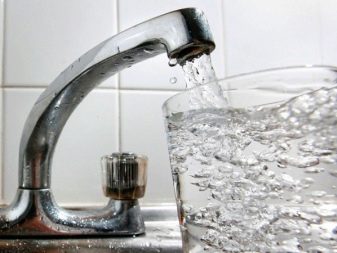How to dilute water-based paint?

Many modern building materials require additional surface protection. For such purposes, several types of paints are used. Particular attention should be paid to water-based formulations that are safe and versatile. Products of this type are especially popular, as they can cover different types of materials, which makes them in demand in everyday life and at industrial enterprises.

Features of paints
Water-based solutions are artificial mixtures that are used to coat products in order to protect them from corrosion. Products of this kind are especially popular, as they are environmentally friendly for humans and the environment.
The water emulsion consists of several main components:
- Dyes. These are special substances with a homogeneous structure.
- Solvent. As this product, ordinary water is used, which evaporates quickly without emitting unpleasant and harmful odors.
- Binder mixture. The composition of paints can be supplemented with various additions that affect the technical characteristics of solutions.

Water-based paints have several significant advantages over their counterparts:
- Low cost. Everyone can buy such compositions, it will not hit the wallet.
- Drying speed. Some types of mortars acquire strength within a few hours after application.
- Environmental friendliness. The mixtures contain only safe and natural products.
- Good mixing performance. This allows you to change the color of the paint by adding different colors, which should be added to the composition of the solution in the right amount.

Paints of this type are not practical. They can be applied provided that the air temperature is above +5 degrees. Since the mixture contains water, the film layer can be easily wiped off with liquid. Therefore, such paints are used only in relatively dry rooms, where there is no direct effect on the painted surface with aqueous solutions.

Views
Water-based paints have been on the market for a long time. The popularity of the material has led to the emergence of several types of these products. Depending on the type of binder, several types of paints can be distinguished:
- Latex. The most popular solutions that can be washed after drying. The advantage of these products is their ductility, which allows small cracks to be repaired with them.
- Acrylic. The main component of the solution is acrylic resin, which protects materials well from moisture. Such paints are distinguished by their elasticity and high cost.
- Silicone. Here, silicone resins are already used as a binder. Such varieties are plastic.
- Silicate. Paints of this type are not able to qualitatively repel water, therefore it is best to paint surfaces in special protective clothing.
- Polyvinyl acetate. PVA glue is added to the composition of such paint, which qualitatively binds pigments together. This material is the cheapest and most short-lived, so it is rarely used.

We select a solvent
High-quality water-based paints do not need to be diluted, since their consistency has already been brought to optimal performance by the manufacturer himself. But there are certain situations when it is simply necessary to dilute the mixture:
- The paint is thick initially. Such materials are relatively rare. But if there is a need to apply a solvent, how to do it correctly, the manufacturer indicates on the packaging.
- The mixture thickens. This happens when the paint is not used for a long time. The water evaporates from it, and the dye becomes thick and begins to harden. Even if you dissolve such a dried mixture, you will not get the original water-based paint. This is due to the fact that the product, when dried, loses its technical characteristics.


You can dilute a water emulsion in different ways:
- Special mixtures. They are prepared on the basis of water and components that are present in the composition of a particular product. You can buy such formulations in any specialized store, where you will be told the parameters of the mixtures.
- Water. This solution is the main and most affordable. With this liquid, it is easy to dilute any type of paint. Experts recommend using only relatively clean water for such purposes. The presence of inclusions that are visible to the naked eye should not be allowed in the solution.



Dilution technology
Water-based paints interact well with water. Therefore, it is quite easy and quick to dilute such a composition. This process consists of several sequential steps:
- Initially, the required amount of paint should be collected in one container, and clean water should be poured into the second.
- Then liquid is added to the mixture in small portions. It is important to constantly stir the solution, this contributes to an even distribution of all components.
- If it is necessary to change the color, a special color can be topped up with the water. The shade is selected individually, it depends on the characteristics of the original solution. In a similar way, decorative sequins can be introduced into the structure.


When mixing water and a water emulsion, foam may form on the surface of the solution. It is advisable to use the liquid after it has settled and the mixture becomes homogeneous.
Recommendations
Mixing water-based paint is a fairly simple operation that even an untrained person can perform. To get a good mix, there are a few simple guidelines to follow.


Observe the mixing ratio. It is desirable that the volume of added water does not exceed 10% of the total. 1 part should be occupied by the solvent, and 9 by the water-based paint itself.
The exact percentages are often indicated on the packaging. Do not exceed the manufacturer's recommendations, this may lead to the film losing its strength characteristics after hardening.


The water must not be dirty. Not all tap liquid can be used as a solution. Various chemical compounds can also affect the dilution quality. Therefore, it is important to take into account the manufacturer's recommendations.
Dissolve the paint with water at room temperature. Do not use hot liquid as it can break the bonds between the colorant and the base mixture. This will result in loss of durability and performance.
If there is no time, you can mix cold and hot liquid, bringing it to room temperature.


Dilution of water-based paint - the ability to obtain a solution of the desired consistency. This approach will allow you to get not only a reliably protected, but also a beautiful surface that is practical and has a long service life.

For information on what water-based paint is, see the next video.













The comment was sent successfully.